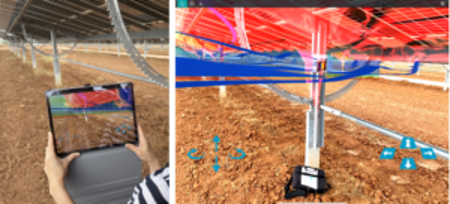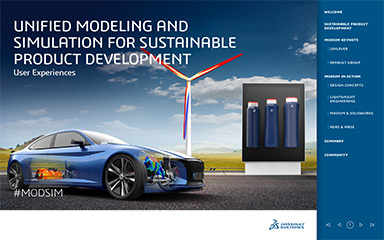
“Simulation gives us the freedom to test hundreds or thousands of designs that don’t seem intuitive at first but might be effective in the long term.” —Eryn Devola, head of Sustainability, Siemens Digital Industries Software.
November 29, 2023
While many view space as the new frontier, some startups are focusing their energy on alternate environments, such as the ocean, in attempts to preserve its beauty or harvest its renewable resources. New design tools and engineering design software and technology offer advances in designs of sustainable ecosystems.
As more emphasis is placed on sustainable design, robust simulation and modeling is playing an important role in building sustainable ecosystems as companies and organizations are dedicated to building robust sustainable ecosystems using advanced engineering design technology.
According to Autodesk’s 2023 State of Design & Make Report, sustainability is a practice that eight out of 10 respondents called “a good long-term business decision.” A whopping 94% of industry leaders surveyed expect to make sustainability-focused changes in coming years not only because it’s the right thing to do from an environmental standpoint, but also because it’s good for the bottom line.
Simulation Influences Sustainable Solutions
“Simulation software and generative design help produce solutions that balance the many trade-offs a designer must consider when putting together their work,” says Daniel Graham, Autodesk senior director for Fusion product management. “A designer does well when balancing four or five competing requirements in a complex project (such as strength, weight, size, cost and manufacturing method).
“Cloud-powered generative design, on the other hand, can take as many requirements into consideration as the designer offers it,” Graham adds. “Complexity is infinite in natural systems, so use of cloud-powered tools Like Autodesk Fusion to balance competing requirements is becoming a best practice among designers of ecological systems.”
Sustainable modeling is advantageous as it allows designers to see a prototype before committing to a more permanent design, says Eryn Devola, head of sustainability for Siemens Digital Industries Software.
“One of the biggest advantages of simulation is that it allows people to try more things digitally before building physical prototypes,” says Devola. “Thirty years ago, when you were developing products, you had to move to the most probable designs—those that you intuitively thought would work.
“Simulation gives us the freedom to test hundreds or thousands of designs that don’t seem intuitive at first but might be effective in the long term,” Devola says. “Being able to test without boundaries is impactful. It brings innovation to life in a more reliable, dependable and sustainable way.”
Simulation is being used to model existing natural processes to better understand their roles in various ecosystems, says Bjorn Sjodin, senior vice president of product management at COMSOL.
“As an example, researchers at Utrecht University in the Netherlands used chemical reaction-type modeling techniques to understand how decaying seashells play a role in maintaining the ocean’s alkalinity and act as a natural trap for human-made carbon dioxide,” says Sjodin.
He explains how a team at Alfred Wegener Institute in Germany used simulation to predict glacier ice melting in Greenland. The German team reportedly developed a viscoelastic model of ice sheet behavior, and instead of using a mechanical CAD model, the traditional basis for a lot of simulation work, they used topographic data from geographic information systems (GIS) as the basis for simulations.
Sjodin adds that a multipurpose simulation software platform such as COMSOL Multiphysics is directly applicable to modeling challenges in sustainable ecosystem development, playing an important role in integrating human-made technology with ecosystems.
“In the Netherlands, engineers employed [computational fluid dynamics (CFD)] simulation to create a more fish-friendly tidal power turbine using the Darrieus rotor design,” he says. “Similarly, Danish engineers used structural analysis to devise an urban rooftop drainage system for rainwater management to support gardens, mitigate noise pollution and help prevent rain from overflowing city drainage systems.”
Mahesh Kailasam is senior vice president and general manager for design and engineering at Hexagon’s Manufacturing Intelligence division.
“We see simulation and modeling as being at the heart of transformation when it comes to sustainability in manufacturing and engineering,” Kailasam says. “These technologies offer a virtual environment where complex scenarios can be analyzed, optimized and refined before being implemented in the real world. This expedites the design and development phase and minimizes the need for physical prototypes and iterative testing, significantly reducing resource consumption and potential waste.”
![]()
Hexagon’s engineering software has been applied by companies like FTC Solar, provider of solar tracker systems, to help engineers understand how strong gusts of wind and storm conditions can damage solar trackers. Image courtesy of Hexagon.
Kailasam adds that simulation also enables us to explore various alternatives in the context of sustainability, identifying scenarios that have the most negligible ecological impact and the greatest efficiency.
“We can simulate the behavior of a new product or subsystem and to understand its material efficiency and energy behaviors, allowing us to fine-tune the process for a minimal environmental footprint,” he says. “The potential for simulation and modeling to achieve positive change continues beyond the product design and development phase—it can extend throughout the entire product lifecycle. Through these tools, we can confidently innovate and accelerate the adoption of environmentally conscious practices, including the choice of manufacturing techniques. Through our continued research and development into sustainable processes, we’re excited to see how these technologies will drive us closer to our vision of empowering an autonomous, sustainable future.”
Energy, Materials and Systems Modeling
Simulation analysis and simulation for sustainability typically falls into three buckets: discovery of energy reduction opportunities, sustainable materials or systems modeling, says Seth Hindman, director for product management at Autodesk.
Energy reduction, he says, is principally driven by sustainability helping produce lighter designs or different technology being used. Simulation focused on materials helps reduce environmental impact by replacing problematic material with something more sustainable. In both cases, physics validates that a product design will meet performance/application requirements.
“In the case of simulation being used for ecosystem modeling, a designer is trying to develop a model representation of a real-world system so they can explore what might be driving an observed outcome,” says Hindman. “Physics are still used, but this is more aimed at a designer trying to better understand a natural system versus validating product performance. The outcome of a systems model may drive requirements that feed a product design.”
In many ways, Hindman says, designing something that will exist in nature, intended to enhance or help support that ecosystem, is “just another design challenge: a set of requirements are defined; materials and manufacturing methods are determined; a design is developed, prototyped, tested and iterated until a final satisfactory design exists; then then we move to production.
“The primary benefits of simulation and cloud-powered analysis, such as improved outcomes in a shorter period of time, easier consideration of a larger pool of design, materials and manufacturing method candidates, and fewer costly prototyping cycles, all apply, whether you’re designing a coral skeleton, an automotive component or a consumer electronics device,” he says.
Integrating Design Standards into Sustainable Designs
Michelle Pagano is the standards and certification project engineer, at the American Society of Mechanical Engineers (ASME) in New York. She accentuates the importance of designing to industry standards. Many standards are already set forth by ASME.
“My perspective is that simulation and modeling technology enables engineers, scientists and practitioners to analyze the feasibility of a design by creating a computational model based on underlying concepts and mathematical principles,” says Pagano. “The computational model can be created prior to the design being implemented on the real-world, physical system to reduce safety and cost risks.
“Standards, such as those established under the ASME Verification, Validation and Uncertainty Quantification (VVUQ) in Computational Modeling and Simulation Standards Committee, help users determine the credibility of computational models and simulations with respect to the physical system that the computational models and simulations are intended to represent,” Pagano adds. “The designation of the ASME VVUQ Standards Committee was originally V&V for ‘Verification and Validation’ in computational modeling and simulation; however, the designation and name were changed in 2021 to recognize the importance of uncertainty quantification.”

Hexagon’s Cradle CFD helps operators visualize hotspots and airflows in situ at Hexagon’s Archidona Solar Farm in Spain. Image courtesy of Hexagon.
Pagano cites an example that involves testing how different pressures, temperatures and chemical elements affect an underwater species.
“The underwater environment is first conceptualized based on its intended use, or context of use,” she says. “The environment’s behavior is modeled in mathematical form based on thermodynamic and chemical principles.”
As Pagano explains it, a computational model of the underwater conditions acting on the species is then developed and executed as an algorithm, computer code to simulate environment behavior. Verification is performed to determine if the computer algorithm is being executed precisely. Validation determines if the computational model can accurately represent the physical system (for example, based on experiments, historical data/environmental properties, and the in-use system) by considering all conditions, measurements, calculations and uncertainties.
By performing these steps, according to Pagano, ideal conditions for sustaining underwater species can be figured out. The figure from ASME V&V 10-2019, Standard for Verification and Validation in Computational Solid Mechanics, shown below shows the elements of VVUQ, which involve evaluating the “Modeling and Simulation Activities” with the “Experimental Activities: to assess the ability of the computational model to represent the physical system and be applied.
Striving for Sustainable Design Outcomes
“Engineers and scientists working with environmental and ecosystem modeling and simulation can take advantage of the vast experiences built up over the last decades in traditional disciplines like stress modeling and fluid flow simulation. Since many simulation platforms are multipurpose software, they can be directly applied to the development of sustainable ecosystems and related tasks,” says COMSOL’s Sjodin. “These projects demonstrate that the benefits of using simulation go beyond conventional industrial analysis, where simulation originated; it is now playing a significant role in projects where understanding a design’s interaction with natural processes is vital.
“This shift promotes sustainable development by aiding participants in anticipating the outcomes of their decisions,” Sjodin adds. “Once simulation has revealed these outcomes, they can be shared with stakeholders prior to project commencement, enhancing transparency.”
Sjodin also says that while more and more engineers and researchers are gaining the skills to leverage modeling and simulation, “not all project teams include simulation experts,” he says.
“However, these teams can collaborate with simulation experts or integrate team members with simulation experience for more effective, and more sustainable, design outcomes,” he adds.
Jim Romeo is a freelance writer based in Chesapeake, VA. Send e-mail about this article to [email protected].
More Autodesk Coverage
More COMSOL Coverage
More Hexagon Coverage

Subscribe to our FREE magazine, FREE email newsletters or both!
About the Author
Jim Romeo is a freelance writer based in Chesapeake, VA. Send e-mail about this article to [email protected].
Follow DE







